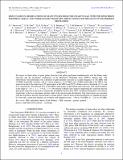SIMULTANEOUS OBSERVATIONS OF GIANT PULSES FROM THE CRAB PULSAR, WITH THE MURCHISON WIDEFIELD ARRAY AND PARKES RADIO TELESCOPE: IMPLICATIONS FOR THE GIANT PULSE EMISSION MECHANISM
Author(s)
Lonsdale, Colin John; McWhirter, Stephen R.; Williams, Christopher Leigh; Cappallo, Roger J; Morgan, Edward H
DownloadOronsaye-2015-SIMULTANEOUS OBSERVA.pdf (582.1Kb)
PUBLISHER_POLICY
Publisher Policy
Article is made available in accordance with the publisher's policy and may be subject to US copyright law. Please refer to the publisher's site for terms of use.
Terms of use
Metadata
Show full item recordAbstract
We report on observations of giant pulses from the Crab pulsar performed simultaneously with the Parkes radio telescope and the incoherent combination of the Murchison Widefield Array (MWA) antenna tiles. The observations were performed over a duration of approximately one hour at a center frequency of 1382 MHz with 340 MHz bandwidth at Parkes, and at a center frequency of 193 MHz with 15 MHz bandwidth at the MWA. Our analysis has led to the detection of 55 giant pulses at the MWA and 2075 at Parkes above a threshold of 3.5σ and 6.5σ, respectively. We detected 51% of the MWA giant pulses at the Parkes radio telescope, with spectral indices in the range of -3.6 > α > -4.9 (S[subscript v] ∝ v[superscript α]). We present a Monte Carlo analysis supporting the conjecture that the giant pulse emission in the Crab is intrinsically broadband, the less than 100% correlation being due to the relative sensitivities of the two instruments and the width of the spectral index distribution. Our observations are consistent with the hypothesis that the spectral index of giant pulses is drawn from normal distribution of standard deviation 0.6, but with a mean that displays an evolution with frequency from −3.00 at 1382 MHz, to −2.85 at 192 MHz.
Date issued
2015-08Department
Haystack Observatory; MIT Kavli Institute for Astrophysics and Space ResearchJournal
The Astrophysical Journal
Publisher
IOP Publishing
Citation
Oronsaye, S. I., S. M. Ord, N. D. R. Bhat, S. E. Tremblay, S. J. McSweeney, S. J. Tingay, W. van Straten, et al. “SIMULTANEOUS OBSERVATIONS OF GIANT PULSES FROM THE CRAB PULSAR, WITH THE MURCHISON WIDEFIELD ARRAY AND PARKES RADIO TELESCOPE: IMPLICATIONS FOR THE GIANT PULSE EMISSION MECHANISM.” The Astrophysical Journal 809, no. 1 (August 7, 2015): 51. © 2015 The American Astronomical Society
Version: Final published version
ISSN
1538-4357
0004-637X